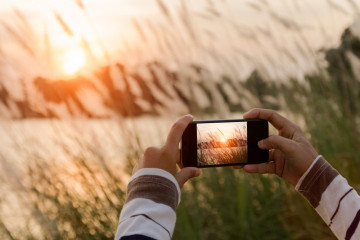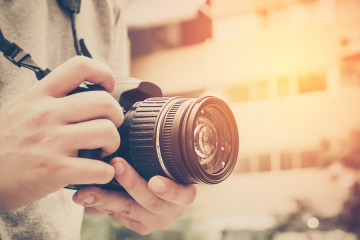People love it when brands create candid content. If you’re a founder or marketer looking to establish an authentic relationship with your audience, then self-recorded videos are something you should experiment with.
Are you hesitant about trying it out? If the only thing holding you back from videoing yourself is the lack of equipment, then don’t fret. You can make good content while filming on your phone.
On the other hand, if you’re worried about the actual process of recording yourself on video, then don’t sweat it. You’ll get the hang of it in no time.
In this post, we’ll walk you through 10 tips so you can nail your first take.
Tips for recording yourself on video
1. Find the perfect spot
- Pick a quiet location with plenty of sunlight or indoor lighting.
- If you’re going to sit down for the video, use a chair that doesn’t swivel or squeak.
- Avoid spots where there’s an echo.
- Turn off the fan and air conditioner to minimize noise.
- Pick a non-distracting background.
Here’s a great example from Wired’s editor-in-chief Nicholas Thompson.
elf on video, then don’t sweat it. You’ll get the hang of it in no time.
In this post, we’ll walk you through 10 tips so you can nail your first take.
Tips for recording yourself on video
1. Find the perfect spot
Pick a quiet location with plenty of sunlight or indoor lighting.
If you’re going to sit down for the video, use a chair that doesn’t swivel or squeak.
Avoid spots where there’s an echo.
Turn off the fan and air conditioner to minimize noise.
Pick a non-distracting background.
Here’s a great example from Wired’s editor-in-chief Nicholas Thompson.
2. Think about what you’ll wear
- Don’t wear clothes that blend in with the background.
- Avoid patterns like stripes.
- Don’t wear a shiny outfit.
- Keep accessories like jewelry to a minimum.
- Make sure your accessories don’t interfere with the audio.
3. Technical specifications
- Resolution: select either 1080 HD or 4K.
- Frame rate: Most videos are shot at the standard 30 fps. For smoother footage, you can select 60 fps.
- If you’re not sure about these specs, then don’t worry. The default setting should work just fine.
4. Set up your smartphone
- To avoid shaky footage, don’t hold your phone in your hand while recording yourself.
- Use a tripod with a smartphone clip and set your device up on a steady surface.
- Keep your smartphone camera at eye level. The results will not do you justice if your device is looking up or down at you.
5. Shoot in landscape mode
- A video shot in landscape format fits well into most social media newsfeeds and looks good on video hosting platforms like YouTube and Vimeo.
- Horizontal videos are generally more aesthetically pleasing and don’t induce claustrophobia. If you upload a video shot vertically on platforms that are more landscape friendly, your video will have vertical bars on the sides.
An exception to the rule: if you’re going to post your video as a story on social media, then go with portrait mode.
6. Pay attention to composition
- Don’t keep the camera so close that your face fills up the entire frame.
- If you’re talking directly to your audience, look into the camera and position yourself in the center. This creates symmetry.
- If you’re having a conversation with someone off-camera, then keep the rule of thirds in mind.
The principle behind this rule is that things look better when you put points of interest on the thirds of your frame; especially where the lines intersect.
So, divide the screen into three vertical sections; then, if you’re talking to someone on the left of the camera, you should position yourself in the right third of the frame. - Don’t forget about the headroom. Typically, you don’t want the top of your head leaving the frame.
7. Get a microphone
- A microphone isn’t necessary, but it would be worth it.
- You could try the Lavalier clip-on microphone for smartphones. It’s omnidirectional and has a high-quality condenser.
8. To zoom, or not to zoom
- Don’t use the digital zoom feature. You’ll lose details and appear pixilated.
- If your device has an optical zoom or a telephoto lens, then the zoom feature will work better.
9. Pay attention to lighting
- Ideally, film yourself in daylight.
- If you’re indoors, position yourself so that the windows are facing you.
- Avoid overhead lighting and backlight.
- Don’t use your phone’s flash.
- Clip-on ring lights are also a good option.
- If you’re indoors and there isn’t enough natural light, you could position two lamps at 45 degree angles from the front of your face and place your smartphone in the middle.
- If you want to go all out, use the three-point lighting setup.
10. Edit your video
If you follow the videoing tips we’ve mentioned in this piece, your video will already be off to a good start, but good editing can take your content to a whole new level.
Install a free video editing software, such as Adobe Premiere Clip, Wondershare FilmoraGo, or Magisto, and polish your content. (All three software are available for both Android and iOS devices.)
Here are some editing basics you should make use of:
- Trim: In the industry, we call it top and tail. It means cutting out some unnecessary footage at the start and at the end of the video.
- Cut: If you fumbled while talking, you could correct it by cutting.
- Add text: you can make your video more eye-catching with text. Add your social media handles too if you’d like.
- Add a thumbnail and an end card: most free video editing software will let you add a thumbnail and an end card for your video. The end card would be a good place to add your video CTA, too.
- Add music – Some video editing apps come with a library of music and sound, if you’d prefer to upload your own track, you can do that as well.
Bonus tips
For those of you who aren’t used to being filmed, these tips will come in handy
- Keep your hand movements to a minimum and don’t cross your arms.
- Whether you’re sitting or standing, pay attention to your posture.
- Relax your shoulders
- If you’re going to use your device’s back camera, use a placeholder to set up the shot.
- Keep a glass of water nearby for clearing your throat.
Bottom line
If all of this seems like too much work, you could always hire a professional video production company to create great content for you.
It may not be the cheapest route, but a good agency will deliver great videos every time so you won’t have to risk having your brand associated with bad quality content.
If you’re interested in working with video marketing professionals, then get in touch with us. We’ve been in the business for over 10 years and we’d love to help you out with your video content goals.


